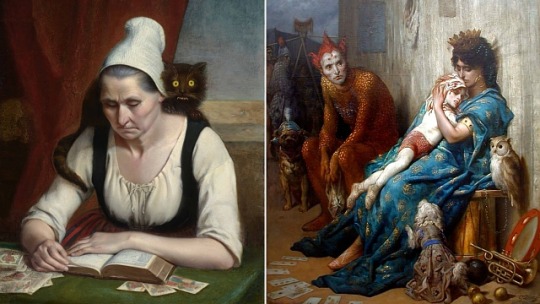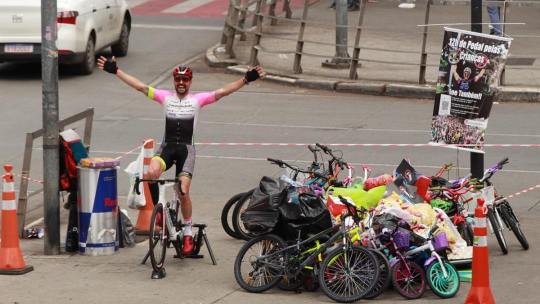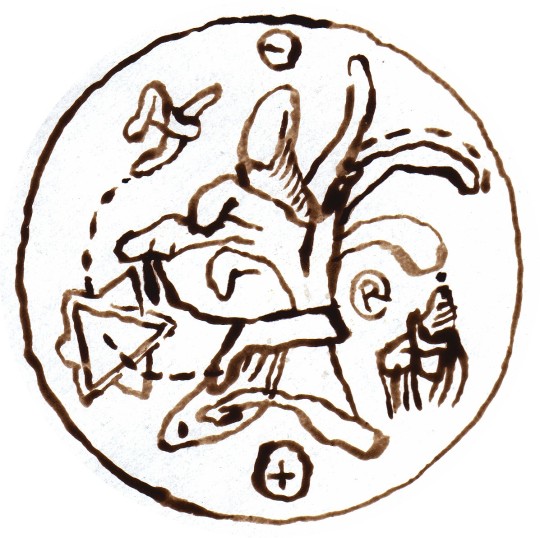#BROU
Explore tagged Tumblr posts
Text
ROAST BEEF
Ingredients: 1 peixet de vedella 4 c/s d’oli d’oliva sal, pebre, llorer, romani 250 ml de conyac 1 got d’aigua brou de carn (opcional) 8 alls tendres 8 escalunyes 2 carxofes 2 patates oli d’oliva Elaboració: El dia abans es posa a macerar la carn amb tots els ingredients excepte l’aigua a una safata que pugui anar al forn i al foc (si és amb tapa molt millor). Es deixa a la nevera i se li va…

View On WordPress
#AIGUA#ALL#ALLS TENDRES#BROU#CARN#CARXOFA (ESCARXOFA)#CONYAC#CUINA#DESTIL·LAT#ESCALUNYA#FARIGOLA#FILET DE VEDELLA#LICOR#LLORER#MITJANA DE VEDELLA#OLI#OLI D&039;OLIVA#ORENGA#PATATES#PEBRE NEGRE#PEIXET DE VEDELLA#RECEPTA#ROMANI#SAL#SEGONS PLATS#TALL RODO DE VEDELLA#VEDELLA#VERDURA#VI DE LICOR#VI RANCI
1 note
·
View note
Photo

EXPOSITION | Prédictions, les artistes face à l’avenir ➽ https://bit.ly/Exposition-Predictions-Artistes Qui n’a jamais rêvé de savoir de quoi demain sera fait ? À travers le monde et le temps, l'humanité tente de percer les mystères de son avenir. Individuelles ou collectives, rationnelles ou non, les prédictions sont multiples. Témoins du monde qui les entoure, les artistes se sont saisis de cette préoccupation de l’avenir
2 notes
·
View notes
Text

Au chalet de Brou, bar, restaurant, thé, Bourg-en-Bresse, Ain.
2 notes
·
View notes
Text

Mansion called Château de l'Aiguille in Brou, Perche region of northern France
French vintage postcard
#brou#historic#chteau#photo#briefkaart#vintage#region#gout#called#sepia#photography#carte postale#postcard#château de l'aiguille#postkarte#france#postal#tarjeta#northern#ansichtskarte#french#old#ephemera#de#postkaart#perche#mansion#perche-gouët#laiguille
3 notes
·
View notes
Text
New Post has been published on Dicas De Mulher
New Post has been published on http://dicasdemulher.tk/2023/11/funcionarios-da-openai-ameacam-sair-da-empresa-se-diretores-nao-renunciarem/
Funcionários da OpenAI ameaçam sair da empresa se diretores não renunciarem
Carta aberta dos funcionários da OpenAI pede para que conselho de diretores abandone o cargo e traga de volta Sam Altman e Greg Brockman
A crise na OpenAI continua: uma carta aberta dos funcionários da empresa pede para que o conselho de diretores renuncie ao cargo e traga de volta o ex-CEO, Sam Altman, e o ex-presidente, Greg Brockman. Caso contrário, essas pessoas garantem que há uma proposta para trabalharem na nova divisão de IA liderada por Altman na Microsoft.
De acordo com a Wired, o documento foi assinado por mais de 600 dos 770 funcionários da criadora do ChatGPT. O texto acusa o quadro de diretores de não oferecer evidências escritas sobre a demissão de Sam Altman, que ocorreu na última sexta-feira (17) e afirma que “a conduta deixou claro que não possuem a competência para supervisionar a OpenAI”.
Outra parte do documento revela que o time de liderança da OpenAI tentou cooperar com a diretoria e oferecer o melhor resultado possível. No entanto, a troca da CEO interina Mira Murati por Emmett Shear também atrapalhou o processo e foi “contra os melhores interesses da companhia”, de acordo com os profissionais.
Um print da carta publicado pela jornalista Kara Swisher mostra alguns nomes conhecidos da empresa que assinaram o documento. O primeiro é o de Mira Murati, CTO da OpenAI que assumiu o cargo de Altman interinamente após a saída do executivo.
O segundo é o de Ilya Sutskever, co-fundador do projeto, cientista-chefe e membro do quadro de diretores — alguns rumores até apontam que a demissão foi resultado de desavenças entre Sutskever e Altman, que culminaria num “golpe” interno para minar o então CEO.
O diretor, inclusive, comentou no X (antigo Twitter) que se arrependia das decisões tomadas no quadro e que “nunca quis prejudicar a OpenAI”.
I deeply regret my participation in the board’s actions. I never intended to harm OpenAI. I love everything we’ve built together and I will do everything I can to reunite the company. — Ilya Sutskever (@ilyasut) November 20, 2023
Veja a nota completa, traduzida para o português:
Para o Quadro de Diretores da OpenAI,
A OpenAI é líder mundial em IA. Nós, funcionários da OpenAI, desenvolvemos os melhores modelos e abrimos campo para novas fronteiras. Nosso trabalho em segurança e controle de IA molda as normas globais. Os produtos que construímos são usados por milhões de pessoas ao redor do mundo. A companhia em que trabalhamos e valorizamos nunca esteve numa posição tão forte, até agora.
O processo no qual vocês demitiram Sam Altman e removeram Greg Brockman do quadro prejudicou todo esse trabalho e minou nossa missão e empresa. Sua conduta deixou claro que vocês não tinham a competência para supervisionar a OpenAI.
Quando n��s inesperadamente soubemos da decisão, o time de liderança da OpenAI atuou rapidamente para estabilizar a empresa. Eles ouviram suas queixas com cuidado e tentaram cooperar em todas as frentes. Apesar de muitos pedidos de fato específicos sobre suas alegações, vocês nunca mostraram nenhuma evidência escrita. Eles também perceberam que vocês não eram capazes de carregar com suas responsabilidades e estavam negociando em má-fé.
O time de liderança sugeriu que o caminho mais estável — aquele que melhor serviria nossa missão, empresa, investidores, empregados e público — seria que vocês pedissem demissão e colocassem no lugar um quadro qualificado para liderar a empresa com estabilidade.
A liderança trabalhou com vocês para encontrar um desfecho mútuo. Mesmo assim, dois dias após a decisão inicial, vocês novamente substituíram a CEO interina Mira Murati contra os melhores interesses da empresa. Vocês ainda informaram a liderança que permitir que a companhia fosse destruída “seria consistente com a missão”.
Suas ações tornaram claro que vocês são incapazes de supervisionar a OpenAI. Nós não podemos trabalhar com pessoas que não possuem competência, julgamento e zelo pela nossa missão e funcionários. Nós, do abaixo-assinado, podemos optar por sair da OpenAI e ingressar na nova subsidiária anunciada pela Microsoft liderada por Sam Altman e Greg Brockman. A Microsoft nos garantiu que existem vagas para todos os funcionários da OpenAI nessa subsidiária caso queiramos participar. Tomaremos essa decisão de forma iminente, a não ser que todos os membros do quadro atual peçam demissão e o conselho anuncie dois novos diretores independentes, como Bret Taylor e Will Hurd, e recontrate Sam Altman e Greg Brockman.
Entenda o ocorrido
A OpenAI pegou muita gente de surpresa com a demissão do CEO Sam Altman. Em nota, os diretores revelaram que o executivo “não era consistentemente sincero nas suas comunicações com o conselho” e colocou Mira Murati como interina no cargo.
Investidores da OpenAI, como a Microsoft, tentaram pressionar o conselho para que a decisão fosse revertida, mas sem sucesso. Então, a empresa fundada por Bill Gates anunciou a contratação de Altman como CEO de uma nova equipe de pesquisa em IA na manhã desta segunda-feira (20).
Internamente, a decisão não foi bem recebida pela falta de clareza das informações: o presidente da companhia, Greg Brockman, saiu do cargo, também foi contratado pela Microsoft e ainda levou outros funcionários para a empresa.
A OpenAI fez mais uma movimentação com a chegada de Emmett Shear para o cargo de CEO interino , substituindo Mira Murati. Shear é o co-fundador da Twitch, teve a mesma função de liderança na plataforma de streaming até 2023 e já anunciou que vai iniciar uma investigação para apurar o que aconteceu com a saída de Altman.
Vale lembrar que a OpenAI opera em duas frentes: uma organização sem fins lucrativos, chamada Open AI Inc., com o respectivo quadro de diretores que toma decisões com base na missão do projeto; e uma subsidiária com lucros limitados, chamada OpenAI LP. Essa empresa precisa seguir todas as decisões do conselho.
Ainda não há um posicionamento oficial da diretoria da OpenAI sobre o assunto, mas a pressão está ainda maior com a possibilidade de demissão da maioria dos funcionários. Como resultado, boa parte das lideranças e da equipe poderia partir para a Microsoft, que já é uma das investidoras no projeto e poderia ampliar a força sobre a empresa.
0 notes
Text
Brou pedala 12 horas e arrecada 2 mil brinquedos para as crianças
O mineiro Thiago Drews realizou a ação "12 horas pelas crianças! O sonho nunca acaba!"

View On WordPress
0 notes
Text
I promise im going to stop saying " im not so active on tumblr🤪" jeez








#interact with my flopped blog plzzzz#no actually you should bc i come to visit here once in a month#im like jesus returning to the earth brou/j#osomatsu san#artwork#drawing#ososan#fypシ#original art#fanart#osomatsu fanart#art
22 notes
·
View notes
Text

Décor urbain.
#photographie urbaine#urban photography#couleurs urbaines#urban colors#decor urbain#urban decor#géométrie urbaine#urban geometry#abstraction#figuration#minimalisme#minimalism#boulevard de brou#01000#bourg en bresse#ain#auvergne rhône alpes#france#photographers on tumblr#poltredlyon#lyonurb#brumpicts#frédéric brumby
45 notes
·
View notes
Text
i think i might js jump off a cliff cause what...
2 notes
·
View notes
Text
POLLASTRE AMB ESCAMARLANS
Ingredients (4p): 1 pollastre 16 escamarlans 2 cebes 4 tomàquets madurs farina canyella en pols sal i pebre Per la picada: 2 grans d’all 8 ametlles 8 avellanes 1 branca de julivert el fetge del pollastre fregit (opcional) 1 got de vi blanc 1 o 2 c/s cassalla oli d’oliva fumet de peix Elaboració: Es talla el pollastre a vuitens, es salpebre, se li tira un pols de canyella, s’enfarina. En una…

View On WordPress
#ALL#AMETLLES#AVELLANES#AVIRAM#BROU#CANYELLA#CASSALLA#CEBA#CUINA#DESTIL·LAT#ESCAMARLANS#FARINA#FRUITA SECA#JULIVERT#MARISC#OLI#OLI D&039;OLIVA#PEBRE NEGRE#POLLASTRE#RECEPTA#SAL#SEGONS PLATS#TOMAQUET#VERDURA#VI#VI BLANC
0 notes
Text
i want to go home
#stupid store rhhhh#i wish i brou gk t my headphones now i want to lock myself ip#atomic’s irrelevant talking
7 notes
·
View notes
Text

Sans titre Brou de noix maison sur couvercle de fromage (10.5 cm de diamètre)
#art#abstract#artists on tumblr#drawing#artist on tumblr#dessin#contemporaryart#abstrait#abstractart#brou de noix#wallnut husk#disegnoastratto
20 notes
·
View notes
Text
By Sharon Brous
Rabbi Brous is the founding and senior rabbi of Ikar, a Jewish community based in Los Angeles, and the author of “The Amen Effect.”
A somewhat obscure text, about 2,000 years old, has been my unlikely teacher and guide for the past many years, and my north star these last several months, as so many of us have felt as if we’ve been drowning in an ocean of sorrow and helplessness.
Buried deep within the Mishnah, a Jewish legal compendium from around the third century, is an ancient practice reflecting a deep understanding of the human psyche and spirit: When your heart is broken, when the specter of death visits your family, when you feel lost and alone and inclined to retreat, you show up. You entrust your pain to the community.
The text, Middot 2:2, describes a pilgrimage ritual from the time of the Second Temple. Several times each year, hundreds of thousands of Jews would ascend to Jerusalem, the center of Jewish religious and political life. They would climb the steps of the Temple Mount and enter its enormous plaza, turning to the right en masse, circling counterclockwise.
Meanwhile, the brokenhearted, the mourners (and here I would also include the lonely and the sick), would make this same ritual walk but they would turn to the left and circle in the opposite direction: every step against the current.
And each person who encountered someone in pain would look into that person’s eyes and inquire: “What happened to you? Why does your heart ache?”
“My father died,” a person might say. “There are so many things I never got to say to him.” Or perhaps: “My partner left. I was completely blindsided.” Or: “My child is sick. We’re awaiting the test results.”
Those who walked from the right would offer a blessing: “May the Holy One comfort you,” they would say. “You are not alone.” And then they would continue to walk until the next person approached.
This timeless wisdom speaks to what it means to be human in a world of pain. This year, you walk the path of the anguished. Perhaps next year, it will be me. I hold your broken heart knowing that one day you will hold mine.
I read in this text many profound lessons, two particularly pertinent in our time, when so many of us feel that we are breaking. First, do not take your broken heart and go home. Don’t isolate. Step toward those whom you know will hold you tenderly.
And on your good days — the days when you can breathe — show up then, too. Because the very fact of seeing those who are walking against the current, people who can barely hold on, and asking, with an open heart, “Tell me about your sorrow,” may be the deepest affirmation of our humanity, even in terribly inhumane times.
It is an expression of both love and sacred responsibility to turn to another person in her moment of deepest anguish and say: “Your sorrow may scare me, it may unsettle me. But I will not abandon you. I will meet your grief with relentless love.”
We cannot magically fix one another’s broken hearts. But we can find each other in our most vulnerable moments and wrap each other up in a circle of care. We can humbly promise each other, “I can’t take your pain away, but I can promise you won’t have to hold it alone.”
Showing up for one another doesn’t require heroic gestures. It means training ourselves to approach, even when our instinct tells us to withdraw. It means picking up the phone and calling our friend or colleague who is suffering. It means going to the funeral and to the house of mourning. It also means going to the wedding and to the birthday dinner. Reach out in your strength, step forward in your vulnerability. Err on the side of presence.
Small, tender gestures remind us that we are not helpless, even in the face of grave human suffering. We maintain the ability, even in the dark of night, to find our way to one another. We need this, especially now.
Here’s the second lesson from that ancient text. Humans naturally incline toward the known. Our tribes can uplift us, order our lives, give them meaning and purpose, direction and pride. But the tribal instinct can also be perilous. The more closely we identify with our tribe, the more likely we are to dismiss or even feel hostility toward those outside it.
One of the great casualties of tribalism is curiosity. And when we are no longer curious, when we don’t try to imagine or understand what another person is thinking or feeling or where her pain comes from, our hearts begin to narrow. We become less compassionate and more entrenched in our own worldviews.
Trauma exacerbates this trend. It reinforces an instinct to turn away from one another, rather than make ourselves even more vulnerable.
There is another important lesson from that ancient text. On pilgrimage, those who enter the sacred circle and turn left when nearly everyone else turns right are grieving or unwell. But the text offers that there is another who turns to the left: the person sentenced to ostracization — in Hebrew, the menudeh.
Ostracization was a punishment used sparingly in ancient times. It only applied to people who were believed to have brought serious harm to the social fabric of the community. The ostracized were essentially temporarily excommunicated. They had to distance themselves from their colleagues and loved ones, they were not counted in a prayer quorum, and they were prohibited from engaging in most social interactions. And incredibly, they, too, entered the sacred space, where they, too, were asked: “Tell me, what happened to you? What’s your story?” And they, too, were blessed.
This is breathtaking. The ancient rabbis ask us to imagine a society in which no person is disposable. Even those who have hurt us, even those with views antithetical to ours must be seen in their humanity and held with curiosity and care.
We desperately need a spiritual rewiring in our time. Imagine a society in which we learn to see one another in our pain, to ask one another, “What happened to you?” Imagine that we hear one another’s stories, say amen to one another’s pain, and even pray for one another’s healing. I call this the amen effect: sincere, tender encounters that help us forge new spiritual and neural pathways by reminding us that our lives and our destinies are entwined. Because, ultimately, it is only by finding our way to one another that we will begin to heal.
15 notes
·
View notes

